|
|
|
Sort Order |
|
|
|
Items / Page
|
|
|
|
|
|
|
| Srl | Item |
| 1 |
ID:
189326


|
|
|
|
|
| Summary/Abstract |
Since 2016, Australia's attitude toward China has taken a turn for the worse, and Sino-Australian relations have seen a significant decline. With regard to the change in Australia's attitude toward China, Chinese scholars initially analyzed it mainly from the perspective of the U.S.-Australia alliance and the China-U.S.-Australia triangle, viewing U.S. influence as the key reason for the change in Australia's policy toward China. Later, Chinese scholars have become increasingly aware of the significant policy autonomy in Australia's China policy and the inadequacy of viewing Australia's China policy from the U.S. perspective. On the one hand, Australia's unique threat perception and interest perception have shaped the characteristics of its China policy; on the other hand, how to effectively balance security interests and economic interests is a long-standing dilemma faced by Australia under the strategic competition between China and the U.S. The Australian government has shown a degree of policy flexibility in its approach. The limited coercive economic measures taken by China against Australia have sent clear policy signals to Australia and have become a factor influencing its policy towards China. In the coming period, although no obvious opportunity for improvement in China-Australia relations is in sight, both sides may be more prudent and pragmatic strategically, and China-Australia relations can be expected to remain basically stable at a low level.
|
|
|
|
|
|
|
|
|
|
|
|
|
|
|
|
| 2 |
ID:
189319
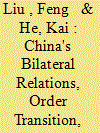

|
|
|
|
|
| Summary/Abstract |
The shifting balance of power and the growing strategic competition between China and the United States have accelerated the order transition in the international system. The nature and process of the order transition, peacefully or confrontationally, largely depend on how China interacts with the United States and other players in the region, especially Australia, Japan, and India. In this article, we introduce an "interest-threat nexus" model to shed some light on why China has formed different types of bilateral relations with key players in the region. We argue that China's bilateral relations are shaped by two perceptual factors: security threat and economic interest. While the threat perception shapes the "identity" feature of the bilateral relationship as partnership or rivalry, the "behavioral" feature of the relationship—cooperative or competitive in action—is largely influenced by the economic interests between the two countries. A systematic and nuanced analysis of China's bilateral relations with major regional players will help us to understand the changing dynamics of the order transition in the Indo Pacific.
|
|
|
|
|
|
|
|
|
|
|
|
|
|
|
|
| 3 |
ID:
189318
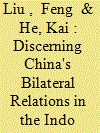

|
|
|
|
|
| Summary/Abstract |
The strategic competition between the United States and China has become a defining feature of international relations in the Indo Pacific. How China interacts with the United States and other major players in the Indo Pacific will shape the nature and process of the potential international order transition, either peacefully or confrontationally, into the future. This special feature systematically explores China's bilateral relations with five key players in the Indo Pacific, the United States, Japan, India, Australia, and ASEAN. By both theoretically unpacking bilateral relations between states and empirically examining China's strategic interactions with others in the region, this project aims to shed light on the complexity of China's bilateral relationships in the region. Each bilateral relationship is studied from both sides of the coin, i.e., by scholars from inside and outside China. This project explores the divergent perspectives between Chinese scholars and non-Chinese specialists on the same bilateral relationship in a pairwise fashion. The insights provided by this study will enrich our understanding of strategic dynamics during the period of potential order transition in the Indo Pacific against the background of U.S.-China strategic competition.
|
|
|
|
|
|
|
|
|
|
|
|
|
|
|
|
| 4 |
ID:
189327
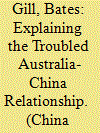

|
|
|
|
|
| Summary/Abstract |
Across a range of indicators, relations between Australia and the People's Republic of China have sunk to their lowest level since they established diplomatic relations in 1972. What explains this dramatic shift in Australia-China ties and what are the prospects for the relationship going forward? Applying a basic neoclassical realist framework, the article argues that Australia's more cautious, distrustful, and defensive policies toward China arise from changes in the international power structure—especially the PRC's emergence as a stronger and more influential actor—and how in turn those changes are interpreted through Australian domestic norms, worldviews, processes, and incentives. The article explores and explains these developments through a discussion of the overarching geostrategic and normative precepts which have consistently shaped Australia's past, present and future approach to the world, including its approach to relations with China; the application of a neoclassical realist framework for understanding the changes in Australian policies toward China; an in-depth look at three key intervening domestic variables which shape Australia's increasingly tough approach to China; and an overview of the key Australian policy outcomes vis-à-vis China. Based on this analysis, the article finds that Australia-China relations will likely face a prolonged period of tension and distrust.
|
|
|
|
|
|
|
|
|
|
|
|
|
|
|
|
| 5 |
ID:
189329


|
|
|
|
|
| Summary/Abstract |
ASEAN-China relations do not fit neatly within the rubric of bilateral ties, unlike the set of dyadic interactions examined in this collection. ASEAN is a disparate collection of states that sometimes work with each other with some mutual understanding about consensus, non-intervention, and autonomy, claims about centrality notwithstanding. Domestically, ASEAN members need also to navigate various political cleavages and latent anti-colonial, even PRC-skeptical, sentiments that can emerge when interacting with China. Any position or arrangement the grouping undertakes with respect to China, particularly the Chinese state, must first overcome these coordination problems. One way is through the presence of a common focal point among ASEAN members, which can be difficult to realize. ASEAN's unwieldy policy making process, born from an initial desire to deescalate tensions and avoid conflict among members, can prevent the group and its members from being forced to take positions by major powers, including the People's Republic of China (PRC). This is exemplified by ASEAN's repeated claims of wanting to avoid a choice between the United States and PRC to sidestep difficult decisions that may invite major power blowback. Yet, this slow and halting approach also stymies ASEAN's ability to take the initiative and establish conditions that enable meaningful autonomy when U.S.-PRC competition is intensifying. This article explains why this phenomenon persists despite the growing risks it poses to ASEAN and its relations with the PRC.
|
|
|
|
|
|
|
|
|
|
|
|
|
|
|
|
| 6 |
ID:
189323


|
|
|
|
|
| Summary/Abstract |
The bilateral relation between India and China in the coming decades will shape the Asian landscape, and arguably the global order as well. Similar yet distinct in several ways, China and India are inheritors of ancient civilizations, colonial depredations, significant geographic expanse, considerable demographic foundations, robust internal political systems and expanding economies. Historically both have been significant players in the global order, but their rising profiles and geographic proximity complicate their contemporary relationship. Despite an initial period of bonhomie, the rivalry between China and India predates the Asian century; their concurrent rise in the post-Cold War era has only contributed to the complexity. Since the Sino-Indian border clashes of 1962, India has consistently sought to balance China—however the precise method and mechanisms to do so have remained inchoate. The clashes on the Himalayan border in 2020 however had the effect of removing residual doubts in India about the confrontational dynamics of the relation—in both elite and public opinion—and this is an extraordinary and irreversible shift in India's policy on China. These events accelerated a series of steps by New Delhi, which can be best understood primarily through the lens of internal balancing. Notably, these nascent steps are occurring in parallel to global developments like recent policy expressions on the Indo-Pacific in varying degrees across countries. This paper explores the evolving trajectory of Sino-Indian relations from the perspective of India's foreign policy and national security priorities and situates it within the broader global context.
|
|
|
|
|
|
|
|
|
|
|
|
|
|
|
|
| 7 |
ID:
189320
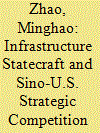

|
|
|
|
|
| Summary/Abstract |
Major powers are advancing strategic competition in infrastructure building in the developing world. They cultivate their infrastructure statecraft by securing financial and technological resources, making institutional arrangements, and managing infrastructure-related consequences. The infrastructure statecraft which covers physical and digital infrastructure as well as hard and soft infrastructure has connotations of geopolitics, geoeconomics and geotechnology. The Sino-U.S. strategic competition in the infrastructure of the Indo-Pacific has intensified in recent years. China has been proactively advancing infrastructure cooperation under the banner of BRI. The United States has proposed the "free and open Indo-Pacific strategy" and "Partnership for Global Infrastructure and Investment," and it competes with China in the infrastructure field by building networked coalitions with its allies and partners. The infrastructure competition illustrates the development-security nexus challenge of U.S-China rivalry over connectivity in the Indo-Pacific. China has taken measures to readjust the way it advances the Belt and Road Initiative and improves its infrastructure statecraft. This article argues that Sino-U.S. competition on regional infrastructure is not necessarily a zero-sum game.
|
|
|
|
|
|
|
|
|
|
|
|
|
|
|
|
| 8 |
ID:
189324
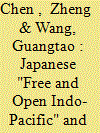

|
|
|
|
|
| Summary/Abstract |
This article examines the Chinese assessment of and responses toward the Japanese "Free and Open Indo-Pacific" (FOIP) concept against the background of evolving Sino-Japanese relations. Addressing both its security and economic concerns, the FOIP is Tokyo's top-level regional strategy design in the context of China's rise. The development of the Japanese FOIP has been fluctuating with the evolution of Sino-Japanese relations and the emerging Sino-U.S. strategic contest over the past decade. The complexity and the fluid nature of the Japanese FOIP has prompted varying assessments and policy recommendations among Chinese analysts, which can be roughly divided into three categories: the hardline approach, the hedging approach, and the docking approach. Meanwhile, remarks of Chinese officials on the Japanese FOIP remain elusive, carefully differentiating between the Indo-Pacific strategy of the United States and that of Japan. All of these aspects reveal the complexity and flexibility of China's policies. The COVID-19 pandemic and the recent domestic changes of Japan and the U.S. have further complicated geopolitical and geoeconomic tensions. As a consequence, the Sino-Japanese relationship has become awkward once again.
|
|
|
|
|
|
|
|
|
|
|
|
|
|
|
|
| 9 |
ID:
189331
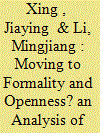

|
|
|
|
|
| Summary/Abstract |
For a long time, China has relied on an informal and covert approach to sanctions in its foreign relations. The past few years, however, have witnessed quite significant changes in Beijing's sanctions policy, as most notably seen in the promulgation of various new domestic regulations and laws as well as official announcements of tit-for-tat punitive measures against Western countries. Why did China so significantly change its sanctions policy? Has China's approach to sanctions moved from informality to formality and from covertness to overtness? And given China's growing zeal in protecting its overseas interests, what are the implications for China's foreign policy? This article attempts to address these questions by analyzing China's latest sanctions behavior. Our findings suggest that China's move was motivated by not only external challenges, particularly sanction pressures from the United States, but also by China's domestic political dynamics including the emphasis in Xi's thoughts on international competition. In reality, China's new sanctions policy and its broader application may be constrained by three factors: China's rhetorical traps, potential market uncertainties, and insufficient asymmetric leverages. It is likely that Beijing may pursue a two-tiered sanctions policy, an explicit countersanctions regime against the U.S. and its allies on one hand and an old-style informal sanctions policy towards other countries on the other hand.
|
|
|
|
|
|
|
|
|
|
|
|
|
|
|
|
| 10 |
ID:
189321


|
|
|
|
|
| Summary/Abstract |
As the world navigates the third decade of the twenty-first century, relations between the United States and the People's Republic of China can best be characterized as elevated great power competition or rivalry. Indeed, at the midpoint of the Joseph R. Biden administration there appears to be greater continuity than change in U.S. China policy and no indication of change in Beijing's policy toward the United States. Thus, a condition of heightened great power competition is likely to extend into the foreseeable future. This competition encompasses multiple dimensions and arenas with a considerable number of contentious issues and significant diverging interests. Key challenges in the bilateral relationship include the need to overcome deep mutual distrust and suspicion and reconcile competing geostrategies. For qualitative improvement not only must the two states address perceptions and misperceptions, but each needs to fundamentally alter their images of the other.
|
|
|
|
|
|
|
|
|
|
|
|
|
|
|
|
| 11 |
ID:
189328
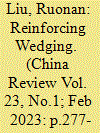

|
|
|
|
|
| Summary/Abstract |
From the Asian financial crisis in 1997 to the year 2010, China's self-restraint and strategic reassurance toward ASEAN countries created a favorable regional environment for its rise. After 2010, the South China Sea disputes and the Sino-U.S. strategic competition intensified. During this period, China simultaneously pursue a wedging strategy which aims to avoid Southeast Asia completely turning toward the United States. Since the Trump administration launched the Indo-Pacific strategy, Sino-U.S. relations have transited from competition to confrontation, significantly increasing the importance of Southeast Asia as a buffer between China and the U.S. At the same time, intensified economic dependence on China for ASEAN countries, and the uncertainty surrounding the U.S.'s strategic attention to the region have increased the costs and risks of alienating China. Both China and ASEAN countries can no longer afford further deterioration in their relations. In the context of the Indo-Pacific strategy, the primary goal of China's Southeast Asia policy is to reduce ASEAN countries' willingness and ability to rely on external powers to exert pressure on it, while strengthening the region's function as a bridge to the global industrial chain and undermining the legitimacy of the Indo-Pacific strategy through advocating ASEAN-led multilateralism. China's Southeast Asia policy effectiveness depends on Beijing's ability to alleviate the internal dilemma within its policy goal, which has been intensified by the Indo-Pacific Strategy. Currently, the Indo-Pacific Strategy has gained some support in Southeast Asia and has weakened the regional countries' domestic support for pro-China policy. Future challenges in China's relations with ASEAN countries do not depend exclusively on the dynamics of the Sino-U.S. relations, given that domestic political changes in key regional countries are closely tied to China's relations with the region.
|
|
|
|
|
|
|
|
|
|
|
|
|
|
|
|
| 12 |
ID:
189332


|
|
|
|
|
| Summary/Abstract |
Comparative scholars have noticed that China's party–military relationship was more fused than the Soviet Union's. This article explores the historical origin of this difference. The author focuses on the understudied commissar system. Based on original Russian and Chinese materials, the author finds that the Chinese Communist Party (CCP) commissar, unlike its Soviet prototype, was more dedicated to breaking the distinction between the revolution and the military. First, the CCP's political workers periodically campaigned against military bureaucracy, though they could not fully eradicate it. Second, in the regular operation of logistical affairs, the CCP's commissars strove to be super-fighters that could replace specialists and technocrats. Third, the CCP political workers had more direct participation in combat, often by their political skills. This made the Chinese Civil War a prototype of contemporary hybrid warfare. Differently, Soviet commissars confined their roles to political monitoring. They tended to leave other affairs to officers and specialists, while at the same time minimizing the change of the original structure of the Tsarist military. In short, the Soviet commissar was a supervisor, while the CCP commissar was a fighter.
|
|
|
|
|
|
|
|
|
|
|
|
|
|
|
|
| 13 |
ID:
189325


|
|
|
|
|
| Summary/Abstract |
Japan's foreign policy on China has generally been successful in handling the delicate balance between the United States and China. Yet, closer analysis shows that Japan's China policy is no weaker than Australia's on issues such as the South China Sea, human rights, and policies on Taiwan. This therefore raises two questions. First, why haven't relations between Japan and China deteriorated as much as they have between China and Australia? And second, why is the Japan-China relationship a stable but fragile one? By modifying the standard strategic triangle model, this article argues that China is pivotal in determining the balance of power in the strategic triangle made up of the United States, Japan, and China. At the same time, the asymmetry of threat perceptions—Japan perceives China as its most significant security concern, while China perceives its greatest security threat as emanating from the United States—gives Japan strategic leverage over China. As a result of China's strategic policies and these asymmetric threat perceptions, relations between Japan and China are ostensibly stable but substantially fragile.
|
|
|
|
|
|
|
|
|
|
|
|
|
|
|
|
| 14 |
ID:
189322


|
|
|
|
|
| Summary/Abstract |
China-India relations are at a crossroads. Since May 2020, the two neighbors have been locked in a protracted border standoff. The format of bilateral engagement based on the delinking of the boundary dispute from cooperation in other areas is under challenge. This article argues that the U.S. factor has been playing a significant role in the evolution of China-India relations since 1988. The U.S. factor impacts China's perception of India and India's policy toward China. Prior to the U.S. strategic shift to great-power competition, China viewed India as a partner and focused on engagement with India. Designating China as a major competitor, India used the U.S. factor as leverage in its relations with China. However, India was suspicious of the cooperative side of the Sino-U.S. relations and chose to hedge between China and the U.S. Since the U.S. has identified China as a strategic competitor and introduced the Indo-Pacific strategy, India has significantly tilted toward the U.S. and embraced the Quad. As the U.S. Indo-Pacific strategy leaves China facing two-front challenges, China's security concerns about India have largely increased. The asymmetry of mutual security perceptions of China and India is decreasing. Since India's China policy is moving from hedging to balancing and China is introducing balancing into its India policy despite commitment to engagement, the two Asian powers might be trapped in a mutual balancing in an era of great-power competition.
|
|
|
|
|
|
|
|
|
|
|
|
|
|
|
|
| 15 |
ID:
189330


|
|
|
|
|
| Summary/Abstract |
It has been argued that Chinese public opinion is often instrumentalized by the government to accomplish maneuverability and flexibility in Chinese foreign policy. Meanwhile, the dynamic social media environment continues to develop in novel and sometimes unanticipated ways that have various consequences for Chinese foreign policy. Can the authoritarian Chinese government dynamically shape public opinion using social media as the main communication channel to produce and collect responses to international affairs? What effect does a highly unified public opinion have on China's foreign policy? The dynamics of posts on Weibo throughout 2020 and the frequency of comments pertaining to specific issues are examined in this study through content and sentiment analysis. The results demonstrate an alignment and suggest a correlation between Chinese public opinion and the attitudes of the party-state on China's foreign policy. The results indicate that Chinese public opinion exhibited an increasing sense of the superiority of China's achievements, an endogenous preference for more hawkish attitudes toward the U.S., and a drive for a "wolf warrior" diplomacy. This is both a consequence of governmental manipulation and education over the long term and a catalyst for a more hawkish foreign policy in the future. In the long run, the highly unified public opinion that has been intentionally created by the party-state may eventually require additional effort to justify foreign policy positions that the public considers insufficiently assertive.
|
|
|
|
|
|
|
|
|
|
|
|
|
|
|
|
|
|
|
|
|